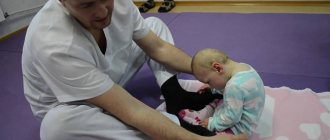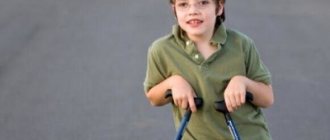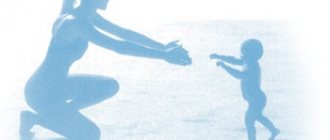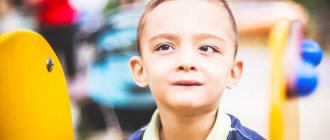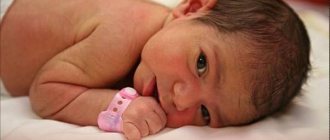August 21, 2021
Spastic diplegia is one of the most common forms of cerebral palsy. It occurs in more than 70% of cases of this disease. For the first time in medicine, spastic diplegia was described by the English doctor Little. During his professional career as an obstetrician, he observed how diplegia manifested itself in newborn children. In honor of the doctor, the pathology received another name - Little's disease.
Causes
In modern medicine, it is customary to identify the following causes that provoke spastic diplegia of the lower extremities:
- premature birth - among the causes of prematurity may be Rh conflict between mother and child, fetoplacental insufficiency, premature placental abruption, late toxicosis in the mother, cardiovascular pathologies, diabetes mellitus, previous injuries;
- injuries to the newborn during childbirth - the risk of birth injury increases with prolonged or rapid labor, breech presentation of the fetus, narrow maternal pelvis;
- hypoxia and asphyxia of the newborn - oxygen deficiency during the period of intrauterine stay of the child negatively affects its development, the risk of pathologies increases if the baby does not breathe independently immediately after birth.
The causes of asphyxia in newborns can be pathological childbirth, intrauterine infections of the fetus, ingress of amniotic fluid, and genetic incompatibility of mother and child.
A certain risk of having a child with cerebral palsy exists when the mother drinks alcoholic beverages and abuses smoking during pregnancy. Provoking factors include the work of a pregnant woman in hazardous work and living in unfavorable environmental conditions.
Spastic diplegia is formed due to damage to the precentral gyrus. It gives rise to pyramidal tracts, which in turn are responsible for motor function. One of the most dangerous factors is intrauterine hypoxia, caused by a lack of oxygen supply to the fetus. Since the brain is very sensitive to a lack of oxygen, pathological changes occur immediately after the onset of oxygen starvation.
Much less frequently, diplegia can result from intracranial birth injuries, causing hemorrhages and destruction of brain tissue.
Causes and risk factors
The reasons for the development of spastic diplegia are no different from the factors that provoke the development of cerebral palsy in a child.
These include the following prerequisites:
- Heredity - sick people have little chance of giving birth to a healthy and healthy child, so during pregnancy you should undergo appropriate examination and take the prescribed treatment.
- And shemia or fetal hypoxia during intrauterine development . Ischemia indicates a disruption in the blood supply to the fetal brain, hypoxia indicates a lack of oxygen. Such reasons lead to brain damage, which can manifest itself in the development of the most severe pathology.
- Infectious lesions of the brain and musculoskeletal system . Infection of a newborn with an infection (can occur in utero) leads to the development of serious diseases in the form of meningitis, encephalitis, arachnoiditis and others. The body is too small to fight such lesions, which often results in complications.
- Toxic factor - a pregnant woman taking potent medications, smoking and alcohol, drugs, being in harmful working conditions - these factors provoke significant damage to the development of the fetus.
- Physical impact - the use of electromagnetic treatment by a pregnant woman, X-ray irradiation, exposure to radioactive radiation - are the reasons for the development of cerebral palsy in a child.
- Mechanical causes are birth injuries or mechanical damage that occurred immediately after birth.
As a result, children whose mothers lead an unhealthy lifestyle during pregnancy, drink alcoholic beverages and adhere to other bad habits, and undergo treatment prohibited during pregnancy are at risk.
Classification
Depending on the intensity of the manifestation, children with cerebral palsy and spastic diplegia may suffer from the following forms of the disease:
- mild - in the first 6 months of life, children are no different from their healthy peers, later problems appear when walking, but arm movements are not limited, the patient can move independently, mental development is not impaired;
- medium - the patient has diplegia of the lower extremities, movement is possible only with the help of improvised means, minor mental damage is also noted, but social adaptation is not impaired;
- severe - this form of cerebral palsy, spastic diplegia, is noticeable from the first months of the child’s life, pronounced tetraparesis is noted with an emphasis on the lower limbs, motor function is completely impaired, patients are not capable of social adaptation in society.
Children with severe spastic diplegia have a negative prognosis for recovery. This pathology is practically untreatable and can lead to death in adolescence.
Hemiplegic (Hemiparetic) form of cerebral palsy
Right-sided hemiparesis This form is most common. It is expressed in paresis, or paralysis, which covers one half of the body. The arm usually suffers more than the leg. Most patients have mental disorders, reduced intelligence (moronicity, idiocy), but such children are capable of learning and usually adapt to life in society and to work. Children with hemiparesis master age-related skills later than healthy ones. Therefore, the level of social adaptation, as a rule, is determined not by the degree of motor defect, but by the intellectual capabilities of the child. Clinically characterized by the development of spastic hemiparesis (Wernicke-Mann type gait, but without leg circumduction), delayed mental and speech development. Sometimes it manifests itself as monoparesis. With this form, focal epileptic seizures often occur.
Symptoms
Spastic diplegia, especially in its mild form, is hardly noticeable in the first months of a child’s life. The newborn baby still has muscle hypertonicity, which he needed during the period of intrauterine development. It gradually weakens, but partially remains until 4-6 months. Hypertonicity, which persists in a child after he reaches six months of age, is one of the signs that makes one suspect spastic diplegia of the lower extremities.
Diplegia in severe form is noticeable from the first days of a baby’s life. Such children are inactive during the period of swaddling and wakefulness, increased muscle tone makes it difficult to bend the limbs.
Other symptoms of spastic diplegia include:
- the characteristic position of the patient’s legs, in which the hips and knees are connected inward, the legs are crossed;
- “dancing” movements when walking, knees rubbing against each other;
- significant delay in motor activity - children begin to walk only at the age of 2-4 years;
- child's tiptoe gait;
- oculomotor disorders, strabismus, decreased visual acuity;
- poor hearing;
- disturbances in the functioning of the speech apparatus, delayed speech development;
- involuntary uncontrolled movements;
- hoarseness of voice.
Diplegia in cerebral palsy is often accompanied by a delay in psychological and speech development. Up to 80% of children diagnosed with spastic diplegia have speaking problems to one degree or another. At the same time, mental retardation is noted in only a quarter of patients with this form of cerebral palsy.
Diagnostics
To determine lower spastic diplagia, a set of diagnostic measures is used. Diagnosis at an early age is often difficult, which creates problems in timely treatment.
Diagnosis is carried out by a pediatric neurologist, and consultations with a pediatrician, ophthalmologist, and otolaryngologist are also prescribed. Pay attention to the history of childbirth, such facts as prematurity, hypoxia during intrauterine development, asphyxia during childbirth.
A neurological examination is of great importance in diagnosis, during which attention is paid to the characteristic signs of disturbances when walking, increased muscle tone, increased tendon reflexes, and impaired skin sensitivity.
Diagnostic measures also include:
- consultation with an ophthalmologist to determine visual acuity and identify oculomotor disorders;
- audiometry by an otolaryngologist, carried out to determine hearing acuity and its possible disorders;
- electroencephalography - performed to assess brain activity;
- neurosonography - necessary to exclude other pathologies with similar symptoms, such as hydrocephalus, cysts, intracranial hematoma;
- MRI of the brain - usually performed when it is necessary to clarify previous diagnostic data.
The child’s level of psycho-speech development is assessed. This is done by a child neurologist (at an early age) or a child psychiatrist. If necessary, tests are performed to determine the level of delay in psychological and speech development or to diagnose mental retardation.
Patient examination and diagnostic criteria
Little's syndrome is diagnosed at an early age - before a year from birth, doctors can make a final diagnosis. The diagnosis itself involves a full comprehensive examination intended for an infant.
Here, an ultrasound of the brain is prescribed, on the basis of which the lesion is detected, as well as radiography, which allows one to determine the delay in bone growth and the presence of contracture.
The main role in diagnosis is played by the identification of relevant symptoms.
Baby up to one year:
- does not hold or raise his head;
- cannot roll over on its own;
- does not pay attention to bright objects;
- cannot sit or sit down by himself;
- does not crawl on his own and does not try;
- does not stand on legs;
- does not involve the affected arm.
At an older age:
- sudden movements are replaced by sluggish ones and vice versa;
- parents note uncontrolled muscle contractions;
- the child makes a lot of unnecessary movements.
The exact diagnosis is determined by:
- revealed fact of delayed bone growth;
- determining the curvature of the hip joint;
- detected development of scoliosis;
- diagnosing the development of contracture;
- manifested by convulsions.
Treatment
Treatment of spastic diplegia in cerebral palsy is aimed at rehabilitation of the child, alleviation of symptoms of the disease, psychological and social adaptation. Working with a defectologist, psychologist, and speech therapist is of great importance to acquire self-care skills and adaptation to society.
Conservative therapy
Drug treatment of diplegia involves prescribing the following groups of drugs:
- vascular agents - normalize blood circulation, improve brain function;
- muscle relaxants - relieve muscle spasms;
- nootropics - stimulate mental activity, activate cognitive functions, improve memory;
- botulinum toxin - relieves spastic tension;
- sedatives - to normalize the psycho-emotional background;
- vitamin and mineral complexes - to achieve a general strengthening effect.
Physiotherapy
Physiotherapeutic procedures for cerebral palsy are prescribed taking into account the characteristics of the child’s body, rapid fatigue and increased excitability of the nervous system of such patients.
Effective physiotherapeutic procedures include:
- electrical stimulation - the use of pulsed currents to improve blood circulation and normalize muscle tone;
- magnetotherapy and the use of ultrasonic waves - used in the treatment of contractures;
- laser therapy - has a beneficial effect on the walls of blood vessels and muscle fibers;
- balneotherapy - the appointment of pine, hydrogen sulfide, turpentine, oxygen and other types of healing baths;
- thermal procedures - paraffin wrap, mud therapy.
Patients with cerebral palsy are prescribed various types of therapeutic massages. Their goal is to strengthen the muscles, relieve tension and excitability in the muscles, and improve blood circulation.
Acupuncture provides effective results in treatment. Influence on biologically active points on the human body allows you to improve the reflex response of organs and tissues. It is best to start acupuncture sessions before the age of one year.
Biologically active points on a child’s skin are located closer to the surface than on adults, so the time the needle remains on the skin is also shorter. It is recommended to conduct 3-4 courses of acupuncture per year. Each course consists of 10 procedures.
Physiotherapy
Exercise therapy is carried out no earlier than one and a half to two hours before or after physiotherapeutic procedures. Exercises are performed in an active-passive mode with the help of an instructor; it is possible to use special gymnastic equipment - a fitball, balls, sandbags.
Physical therapy exercises help build muscle strength, improve coordination of movements, normalize muscle tone, and improve the emotional state of a small patient.
Swimming has a great effect on the human body. Staying in water has a restorative and sedative effect and activates the central nervous system.
Recently, new rehabilitation methods have gained popularity - dolphin therapy (swimming in a pool with dolphins) and hippotherapy (communication and horse riding). Such activities stimulate emotional, tactile and visual communication, helping the child get a charge of optimism and positive, bright emotions.
Specially trained animals send the child over 100 motor impulses, to which the patient’s brain actively reacts.
At least an hour should pass between massage, exercise therapy or physiotherapy procedures. Procedures are not prescribed if the child has signs of acute respiratory diseases, a feverish state, a tendency to bleed, or the presence of neoplasms in the body.
If the disease is accompanied by increased excitability of the child and sleep disorders, electrosleep therapy is indicated. Electrosleep lasting 30-40 minutes is prescribed, procedures are carried out daily or every other day. This type of physiotherapy is not prescribed if cerebral palsy is complicated by epilepsy or hydrocephalus.
Rehabilitation therapy necessarily includes classes with a psychologist, speech pathologist, and special education teachers in specialized institutions. Play therapy allows you to relieve increased anxiety, fears, neuroses, improve sleep and correct behavior. These types of correctional work are indicated for patients who have delayed mental and speech development.
Treatment of Little's syndrome
It is impossible to cure spastic diplegia - you can only soften muscle damage and prepare the child as much as possible for adaptation to social life.
Here, to a greater extent, they resort to general physiotherapeutic rehabilitation procedures, which are prescribed in accordance with the form of the disease and its course.
Possible treatment methods include:
- Massage – professional regular massage improves blood circulation, which prevents the development of contractures and reduces muscle tone. This allows the child to move better.
- Exercise therapy - therapeutic physical education in the presence of cerebral palsy is mandatory. Exercises are selected individually, taking into account the physiological capabilities of the child. Modern devices and complexes are often used to allow the child to do exercises better and more endurance without compromising his health.
- Acupuncture - affects receptors, improving blood circulation. Inserting needles into special points helps prevent the rapid development of contractures and partially relieve muscle tone.
- Swimming is a special technique designed for the implementation of swimming movements by children with pathology, which has a positive effect on the general physiological condition.
- Vojta therapy is a technique developed by Czech neurologist Vaclav Vojta. The method is aimed at restoring motor functions by activating reflexes.
- Adele's suit is a sock of a power system consisting of supporting elements and elastic adjustable rods. The suit allows you to fix the correct position of the child, promoting muscle “memory”.
Drugs for drug treatment include the use of nootropics (Piracetam, Nicergoline, Caffeine and other drugs) and homeopathic drugs (Spascuprel, Verotrum, Natrium and others).
Drug treatment is carried out in the presence of auxiliary lesions in the form of delayed intellectual and psychological development.
Forecast
Cerebral palsy is an incurable disease, so the goal of treatment is to maximize the patient’s adaptation to living in society and improve his overall well-being. Although the overall prognosis for the disease is unfavorable, with proper treatment and additional health procedures, patients with this diagnosis can live to a ripe old age.
With a mild form of the disease, patients can lead a normal life, get education, and work. When choosing a profession, you should definitely take into account the characteristics of your health condition, as well as regularly take courses of preventive treatment and follow all the doctor’s recommendations.
However, only a quarter of patients will be able to move and care for themselves. If a severe degree of the disease is diagnosed, the patient needs constant care and will not be able to lead a full independent life.
Parents of children with cerebral palsy also need psychological help and support. To do this, they can attend special courses and trainings at rehabilitation centers, where they will receive appropriate recommendations for treatment and proper care and will be able to find like-minded people and friends.
Classification of cerebral palsy by severity
Based on severity, cerebral palsy can be divided into three groups:
- severe form of cerebral palsy , that is, children with severe cerebral palsy disorders who cannot move without assistive devices, they lack the skills of standing upright, grasping and holding objects, such patients with cerebral palsy require constant care and a special rehabilitation environment for living;
- medium form - children with moderate disabilities (the largest group) can easily cover short distances and have basic self-care skills;
- mild form - children with mild impairments may experience involuntary movements, abnormal gait and other signs of cerebral palsy, such as speech, vision and hearing disorders, decreased intelligence, but in a mild form.
Complications
The negative consequences of the disease are reflected mainly in the condition of the musculoskeletal system. Possible complications include:
- formation of contractures;
- risk of developing joint pathologies - arthrosis;
- muscle atrophy;
- increased risk of injury resulting from poor coordination of movements, unsteady gait, and falls.
Avoiding complications and achieving the most effective rehabilitation of a child is possible only with timely diagnosis and early initiation of treatment.
Prevention
Prevention of the disease should be carried out during the period of pregnancy by the mother. A pregnant woman must register with a specialized medical institution on time to manage her pregnancy.
During the entire period of bearing a child, it is prohibited to smoke or drink alcoholic beverages. Bad habits reduce the supply of oxygen and increase the risk of developing hypoxia in the fetus.
If a woman was taking medications before pregnancy, she should notify her doctor. Not all medications are safe for the development and health of the unborn baby.
Preventive measures also include following the rules of a balanced diet and eliminating negative emotions during pregnancy. Regular visits to the doctor will help prevent intrauterine developmental disorders.
What do you need to remember?
- spastic diplegia is the most common form of cerebral palsy;
- the disease requires not only the use of drug therapy, but, first of all, a number of health-improving and developmental procedures aimed at adapting the child to society;
- with a mild form of the disease, the child can independently care for himself and lead a normal life, but with regular visits to the doctor;
- Physical therapy exercises play an important role in treatment;
- if indicated, the child is entitled to sanatorium treatment;
- every child with cerebral palsy has the right to rehabilitation with the provision of technical recovery means;
- timely treatment reduces the risk of complications such as contractures, joint pathologies, and muscle atrophy.
Return to list


